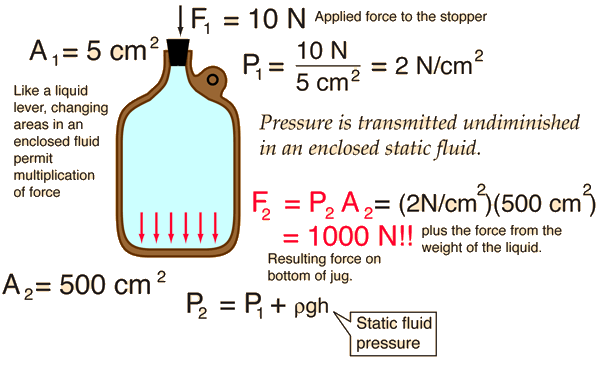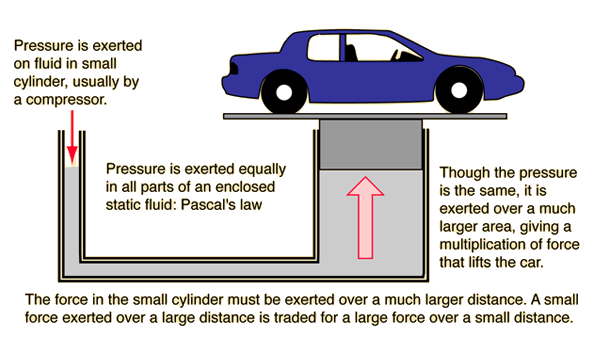Pascal's principle is defined
A change in pressure at any point in an enclosed fluid at rest is transmitted undiminished to all points in the fluid.
This principle is stated mathematically as:

 is the hydrostatic pressure (given in pascals in the SI system), or the difference in pressure at two points within a fluid column, due to the weight of the fluid;
is the hydrostatic pressure (given in pascals in the SI system), or the difference in pressure at two points within a fluid column, due to the weight of the fluid;ρ is the fluid density (in kilograms per cubic meter in the SI system);
g is acceleration due to gravity (normally using the sea level acceleration due to Earth's gravity in metres per second squared);
 is the height of fluid above the point of measurement, or the difference in elevation between the two points within the fluid column (in metres in SI).
is the height of fluid above the point of measurement, or the difference in elevation between the two points within the fluid column (in metres in SI).The intuitive explanation of this formula is that the change in pressure between two elevations is due to the weight of the fluid between the elevations. Note that the variation with height does not depend on any additional pressures. Therefore Pascal's law can be interpreted as saying that any change in pressure applied at any given point of the fluid is transmitted undiminished throughout the fluid.
Applications
- The underlying principle of the hydraulic jack and hydraulic press
- Force amplification in the braking system of most motor vehicles.
- Used in artesian wells, water towers, and dams.
- Scuba divers must understand this principle. At a depth of 10 meters under water, pressure is twice the atmospheric pressure at sea level, and increases by about 100 kPa for each increase of 10 m depth.
- The siphon
Pascal's Principle
Pressure is transmitted undiminished in an enclosed static fluid.

Any externally applied pressure is transmitted to all parts of the enclosed fluid, making possible a large multiplication of force (hydraulic press principle). The pressure at the bottom of the jug is equal to the externally applied pressure on the top of the fluid plus the static fluid pressure from the weight of the liquid.
Hydraulic Press

Automobile Hydraulic Lift
A hydraulic lift for automobiles is an example of a force multiplied by hydraulic press, based on Pascal's principle. The fluid in the small cylinder must be moved much further than the distance the car is lifted.

For example, if the lift cylinder were 25 cm in diameter and the small cylinder were 1.25 cm in diameter, then the ratio of the areas is 400, so the hydraulic press arrangement gives a multiplication of 400 times the force. To lift a 6000 newton car, you would have to exert only 6000 N/400 = 15 N on the fluid in the small cylinder to lift the car. However, to lift the car 10 cm, you would have to move the oil 400 x 10cm = 40 meters. This is practical by pumping oil into this small cylinder with a small compressor.
